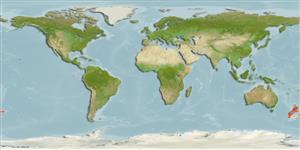Common names from other countries
Environment: milieu / climate zone / depth range / distribution range
Ecologia
Pelágico(a,os,as); intervalo de profundidade 0 - 500 m (Ref. 275). Temperate, preferred 16°C (Ref. 107945); 39°S - 56°S, 165°E - 176°W (Ref. 120902)
Southwest Pacific: New Zealand; Known from the South Island, the southeast coast of the North Island, also from south of the Auckland Island and west to the Chatham Islands.
Length at first maturity / Tamanho / Peso / Idade
Maturity: Lm ? range ? - ? cm Max length : 42.0 cm ML macho/indeterminado; (Ref. 275); Peso máx. publicado: 1.8 kg (Ref. 275); Idade máx. registada: 1.00 anos (Ref. 127344)
Life cycle and mating behavior
Maturidade | Reprodução | Desova | Ovos | Fecundidade | Larvas
Members of the class Cephalopoda are gonochoric. Male and female adults usually die shortly after spawning and brooding, respectively. Mating behavior: Males perform various displays to attract potential females for copulation. During copulation, male grasp the female and inserts the hectocotylus into the female's mantle cavity where fertilization usually occurs. Life cycle: Embryos hatch into planktonic stage and live for some time before they grow larger and take up a benthic existence as adults.
Roper, C.F.E., M.J. Sweeney and C.E. Nauen. 1984. (Ref. 275)
Status na Lista Vermelha da IUCN (Ref. 130435)
Status no CITES (Ref. 108899)
Not Evaluated
Not Evaluated
Uso pelos humanos
Pescarias: espécies comerciais
FAO - pescarias: landings, perfil da espécie | FishSource | Sea Around Us
Ferramentas
Fontes da internet
Estimates based on models
Preferred temperature
(Ref.
115969): 8 - 14.5, mean 11.8 (based on 53 cells).
Resiliência
Médio, tempo mínimo de duplicação da população 1,4 - 4,4 anos (K=0.25).
Vulnerabilidade
Low to moderate vulnerability (32 of 100).
